No other space in the house has undergone as many changes in functionality as the kitchen. This went from being a multifunctional space, where daily activities related to food, hygiene and living were organised, to a monofunctional space, serving only for cooking.
In the kitchen of the Casa da Calçada, the large cast iron stove, with multiple burners and ovens, occupies a prominent place. In the 19th century, the introduction of (charcoal or wood) stoves, replacing the large open fire hearths, made cooking more comfortable and safe and contributed to the transformation of the utensils used in the kitchen. This innovation made the objects used in the preparation of meals, or the heating of liquids, to be redesigned and adapted to the new heat source, now presenting flat bases and handles to be held. The House’s pots, kettles and chocolate-making tools are proof of this.
The kitchens of the bourgeois houses were organised by functions and that of the Casa da Calçada was no exception. There were areas for each activity: the washing area with its sinks (there were originally two); the cupboards and shelves along the walls for storage; and the large installations in the centre, like the current kitchen islands, facilitated the preparation of meals, was spacious and functional, with side drawers and the lower part was protected by a food safety net. The doughs were worked and rolled out on the stone surface of the kneading table. There were also pantries to store the various products and an oven to bake the bread outside.
Credits: Frederico de Freitas House-Museum.


